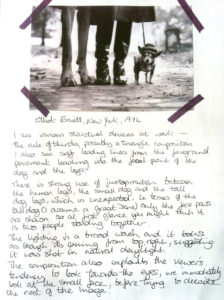
Writing about Erwitt
Exercise: Look carefully at Erwitt’s image, ‘New York, 1974’ make some notes about the structure and the meaning of the photograph.
I did this exercise in my sketchbook early on in Part Four of Context & Narrative, I have found that the physicality of sticking images and writing about them is helpful. For the most part I think I found the compositional elements referred to in the module text – the rule of thirds, possibly a triangular composition, leading lines and so on. The use of juxtaposition is clearly an important visual tool in creating possible confusion in the viewer. For me it took a second to spot the taller dog’s legs and realise it was not two humans standing with the small dog.
I found myself drawn to the eyes of the small dog before I could move on to reading the rest of the photograph. This might be explained by neuroscience’s view that we are hardwired to respond to faces . Now I have come back to my notes I’m not sure I see anything differently so much as having a new language to describe them, i.e., the large dog legs becoming a punctum for me.
If there is a difference it may be that I am more aware of the relationship between denotation and connotation, of what we read into photographs beyond their immediate form. With New York 1974 I now find myself wondering about different metaphors that could be applied in terms of signification – it could be saying something about power relationships, about the human animal, relationships, wealth and exploitation. A myriad of different interpretations could emerge dependent on the context from which I am reading the image.





















